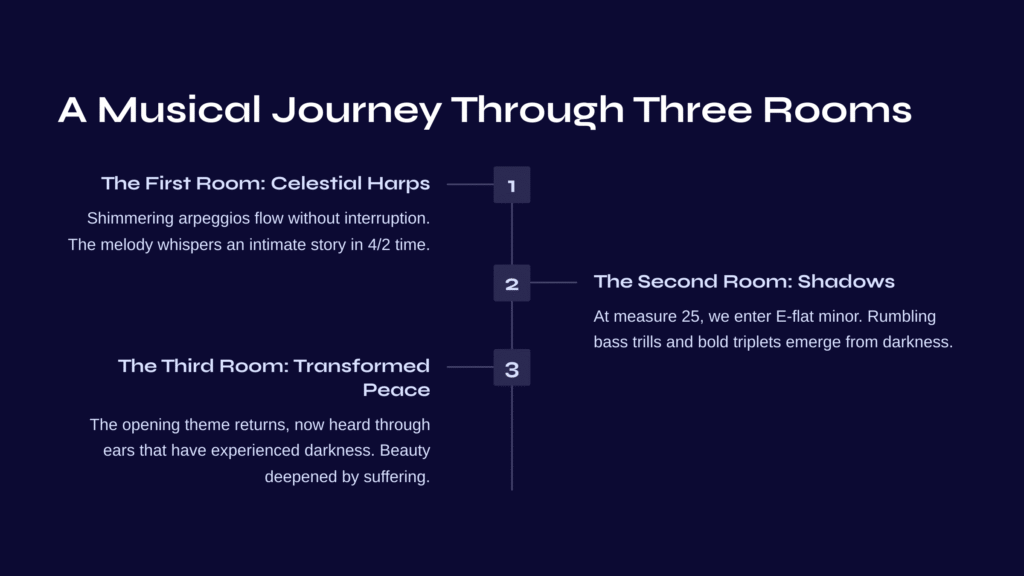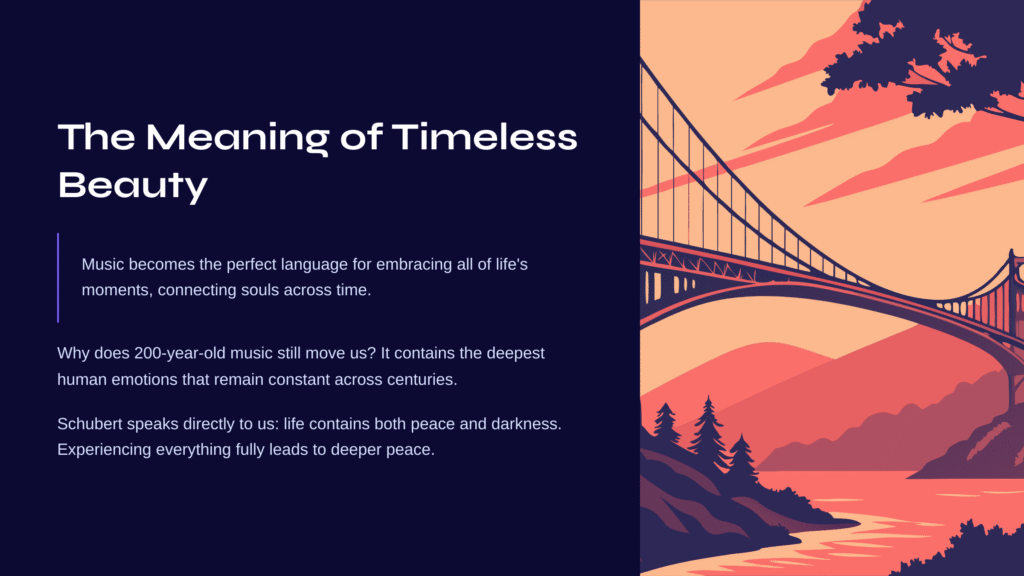Table of Contents

Some Moments Long to Stay Forever
Sometimes music stops time itself. The instant the first note sounds, all the world’s noise fades away, leaving only that melody suspended in space. Every time I listen to Schubert’s Impromptu No. 3 in G-flat major, I experience such a miraculous moment. This piece feels like a secret letter the composer is handing us personally—unhurried, unrushed, existing simply because beautiful things deserve to exist for their own sake.
This work, composed in 1827 by Schubert just one year before his death at the tender age of 31, radiates an astonishing tranquility. Instead of despair or fear, it flows with a quiet beauty that seems to accept everything life has to offer. Have you ever experienced this kind of music where time moves differently, where the ordinary world seems to pause and listen?

The Miracle of 1827: The Birth of Schubert’s Impromptus
The year Schubert composed the Op. 90 Impromptus was the most creatively explosive of his life. Remarkably, in 1827 alone, he produced both sets of Impromptus along with approximately 30 other significant works. It was as if he instinctively knew his time was limited, pouring everything he had into his music with desperate urgency.
Intriguingly, this third Impromptu wasn’t published during Schubert’s lifetime. When it finally appeared in 1857, the publisher made a significant alteration—believing the original G-flat major too challenging for amateur pianists, they transposed it to G major. Yet today’s performers universally prefer the original key, and for good reason: G-flat major flows far more naturally under the fingers and provides what one critic called “gorgeous, resonant warmth” that the transposed version simply cannot match.
During this same period, Schubert was also composing his darkest and most profound song cycle, Winterreise (Winter Journey). The two works, born from the same creative moment, share a mysterious kinship—both embrace life’s solitude and beauty simultaneously, reflecting the composer’s mature acceptance of his fate.

A Musical Journey Through Three Rooms
The First Room: Where Harps Sing Peace
The piece opens with arpeggios that shimmer like celestial harp strings, flowing with gentle persistence. The unusual 4/2 time signature minimizes the visual impact of bar lines, creating an illusion of music that flows without interruption. The right-hand melody begins like someone whispering an intimate story, personal yet universal.
This melody carries the nocturne-like quality reminiscent of Schubert’s own “Ave Maria.” The melodic lines rise and fall like gentle sighs or deep breaths of meditation. Though structured in classical 4+4 bar phrases with perfect balance, the emotions it conveys feel anything but calculated—they emerge as naturally as morning light.
The Second Room: A Journey Through Shadows
Beginning at measure 25, the middle section transports us into an entirely different world. The shift to E-flat minor darkens the atmosphere dramatically. Rumbling bass trills and bold ascending triplets emerge from the shadows. This passage always reminds me of Schubert’s terrifying song “Der Erlkönig”—there’s something of the night’s restless spirits dancing in these measures.
The music modulates frequently, passing through C-flat major before returning to E-flat major, creating harmonic adventures that contrast starkly with the opening’s serenity. It’s like being pulled from a peaceful dream into a vivid nightmare. Yet even in this darkness, Schubert never abandons beauty—he transforms it, deepens it, but never destroys it.
The Third Room: Peace Regained, But Forever Changed
When the opening theme returns, we hear it through ears that have experienced the middle section’s darkness. Though the same melody, it sounds completely transformed—like the calm after a storm. This isn’t the innocent tranquility of the opening, but rather the mature acceptance that comes after weathering life’s tempests.
This is the magic of Schubert’s music: it doesn’t merely present beauty—it shows us beauty that has lived, suffered, and emerged deeper for the experience.

What This Music Means to My Heart
Each time I hear this Impromptu, I feel I understand something more about Schubert’s soul. How could a 31-year-old composer facing death create music of such profound peace? Perhaps because he had already made his peace with everything—the beauty and pain, joy and sorrow of existence. His deep reflection on life’s full spectrum permeates every note.
The contrast between the middle section’s turbulence and the final section’s tranquility moves me deeply. Anyone who has weathered difficult periods in life will recognize these emotions. Schubert tells us through music that we can only find true peace after passing through darkness—that this journey through shadow is not just inevitable but necessary.
This piece is often called a “song without words,” and indeed, you find yourself wanting to sing along with its melodic lines. As a master of lieder, Schubert naturally brought his gift for vocal melody to the piano, achieving something remarkable: making a single instrument sound profoundly human.

Listening Points for Deeper Appreciation
To experience this piece more deeply, I suggest focusing on several key elements.
First, listen to the relationship between the right-hand melody and accompaniment. Schubert requires the pianist to do two things simultaneously: fingers 4 and 5 sing the melody while fingers 1-3 play harp-like arpeggios. Observing how these elements interweave reveals Schubert’s genius for creating complex textures that sound effortless.
Second, pay attention to the subtle art of pedaling. The continuous arpeggios must flow seamlessly while keeping the melody clear and prominent. Comparing recordings by master pianists reveals how this balance can dramatically affect the music’s impact.
Third, I encourage repeated listening. This piece reveals new facets with each hearing. What initially strikes you as simply beautiful gradually unveils layers of complex emotion hidden within that beauty.

The Meaning of Timeless Beauty
Schubert’s Impromptu No. 3 perfectly demonstrates why classical music transcends eras. Why does music composed 200 years ago still move our hearts today? Because it contains not just beautiful sounds, but the deepest human emotions—feelings that remain constant across centuries.
Through this piece, Schubert speaks directly to us: life contains both peaceful and dark moments, but experiencing everything fully leads us to deeper peace. Music becomes the perfect language for embracing all of life’s moments, connecting souls across time.
Every time I hear this Impromptu, I feel time suspend itself. Past, present, and future merge into one. Schubert’s spirit meets mine through music—this is classical music’s true power. It creates a bridge of emotion spanning 200 years, carrying feelings directly from one human heart to another.
Next time you listen to this piece, I invite you to set everything aside and fully receive this beautiful gift Schubert offers. In that moment, you too will step into a world of timeless beauty.

Next Listening Recommendation: Tchaikovsky’s Serenade for Strings, 2nd Movement (Waltz)
After being enchanted by Schubert’s quiet beauty, I’d recommend following with Tchaikovsky’s Serenade for Strings, 2nd Movement Waltz. If Schubert’s Impromptu was an intimate, solitary meditation, Tchaikovsky’s Waltz is a dreamlike dance in an elegant ballroom.
These two pieces offer contrasting charms while sharing something essential: both possess that magical power to make us forget time. Where Schubert offers personal, introspective beauty, Tchaikovsky captivates us with brilliant, social elegance. Moving from the delicacy of solo piano to the richness of string orchestra, from solitary meditation to graceful dance—this contrast creates a perfect journey showcasing classical music’s diverse expressions.
Hearing Tchaikovsky’s Waltz after Schubert’s deep contemplation has settled into your heart feels like awakening from one beautiful dream only to enter another. The transition illuminates how classical music can transport us through entirely different emotional landscapes while maintaining that essential thread of timeless beauty.



